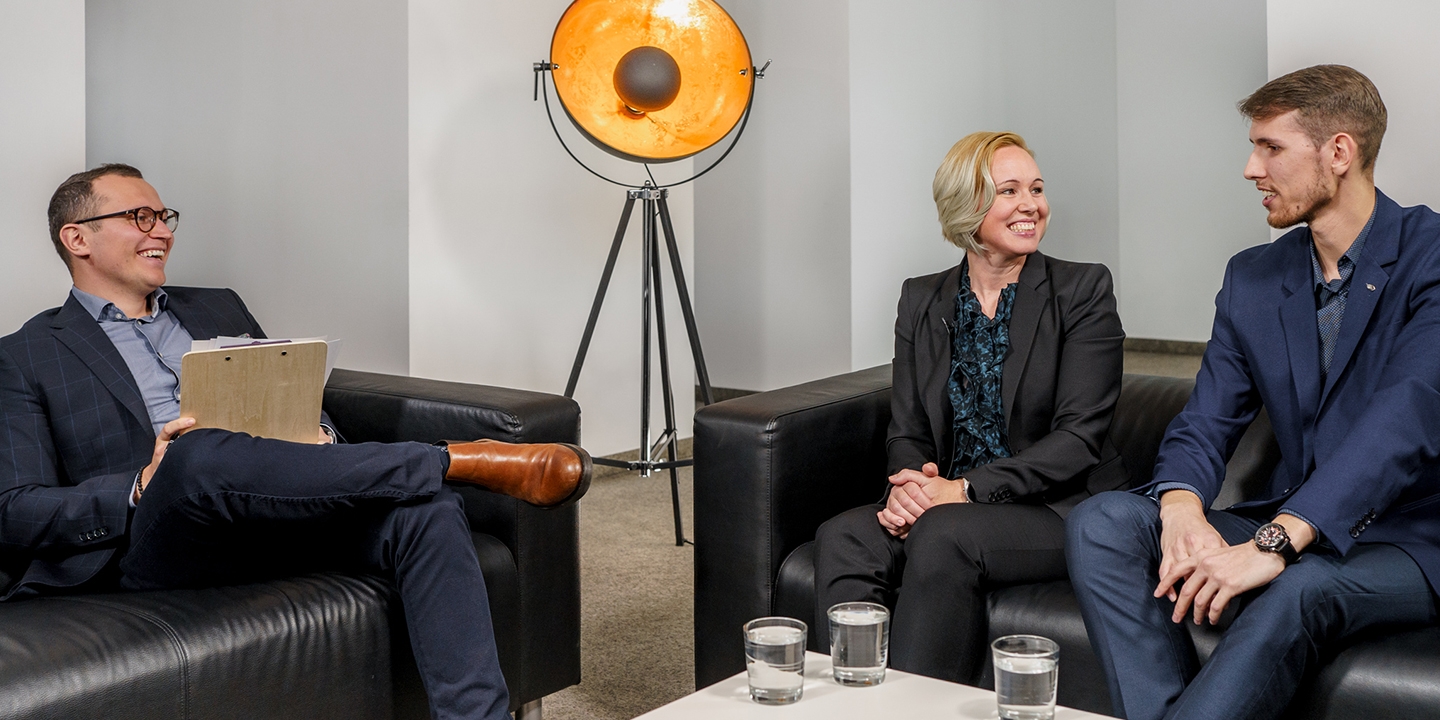- Insights hub
- /
- What value does UX bring ...

What value does UX bring to IT projects? with Daniel Jaros
- DetailsAbout the talks
- TranscriptTranscript
- Resources2 Files
What value does UX bring to IT projects? with Daniel Jaros
Daniel Jaros
Daniel is a Lead Product Designer at Future Processing where he heads a team of 5 UX experts. Over the last 12 years, he has been engaged in the development of 27 digital products for the healthcare, tourism, energy and aviation industries among others.
Michał Grela
Relationship Manager at Future Processing
In this episode, our host talks with Daniel Jaros – an experienced User Experience designer – on what value UX brings to IT projects.
Is User Experience design a would, a could, a should or a must? How to create a service or a product based on customer experiences, one that end users will love?
The discussion covers aspects such as: what makes a great User Experience, what is the role of a UX designer in an IT project, what are the most common challenges UX addresses and what type of businesses can particularly benefit from a well-though UX design.
Michał Grela (MG): My guest today is Daniel [Jaros 00:00:08], great user experience specialist working at Future Processing. Daniel, please introduce yourself. Tell us something more about you, who you are, what you do. What’s your story?
Daniel Jaros (DJ): Hello. I’m Daniel Jaros, and I’m part of Analysis and Design Department, which consists of UX designers and business analysts. For our service, usually we conduct the design process based on user centered-design approach.
MG: Thank you, Daniel. It’s a great pleasure having you here today, and we’re going to talk about user experience. But firstly, first things first, in order to make sure we are all on the same page. What do you mean, what do you understand, when you say, “user experience”? When you think “user experience”?
DJ: Okay, I can simply explain you that sentence, that terminology. Let’s imagine that you would like to buy a railway ticket, and you can use online service to do this. You select connection, departure, and time, and you pay for the ticket. Depending on how quick and easy you can do this, you have a positive or negative experience. In this case, we can talk about user experience at all, but you also can do the same in real life. When you go to the ticket office in the railway station, and you can ask about a connection, buy ticket from the person on the other side of the window. It’s also example of user experience, but in real life also.
MG: So it’s not only a digital term, it’s also real life stuff.
DJ: Yeah, that’s true. Those perspectives sometimes are related for our specific service.
MG: Yeah, it’s all interconnected, yeah.
DJ: Some services can have both touch points, the digital one, and then in real life.
MG: Cool. I really like this example with the train. You can have a great user experience when buying the ticket online, but eventually if the train is late, it’s all for nothing. Daniel, when it comes to user experience, it is a hot and trending topic in recent months, isn’t it? Do you also see it?
DJ: Yeah, I think so. We have some reports and analysis that confirm that. For example, the Customers’ 2020 Report shows that in the next five years, user experience will replace the existing brand features such as product offer and price, and UX will become most important factor detaining the client or encouraging him to abandon the brand. Also Medallia analysis has shown the users with positive brand experience spent 140% more than those with a negative experience. From my observations also, I cannot … Awareness among users is growing, and more often there is a need for the applications to be useful.
MG: Although poor user experience is often a big topic, a big thing, then good and decent usable user experience, when done right, can be definitely more impactful. Few questions more about, just get a better understanding on what you do. What are your three daily typical tasks as a user experience specialist designer?
DJ: Okay. I think those are more three typical areas, because we have plenty of tasks every day regarding user experience, but three typical are user research, solution design, and the evaluation of the solution. When we talk about user research, this is everything that is related with tools and methods that are obtaining information about the goal and the needs of users. For example, we use a technique like interviews with potential users. We can do also contextual interviews in a place where they work and live. We also create profiles of our users and we call that personas. It’s about user research. Next thing is solution design, as I’ve mentioned before, and here popular tools and methods are user flows creating, service design, we also very often do wire frames to shell functionalities in black and white colors, just to have ideas and layout to check the functionalities with the users and confirm our assumption and flow.
MG: What about the evaluation of the solution? You’ve also mentioned that.
DJ: What about evaluation? When we have high fidelity designs, so the colorful idea, we can create interactive prototypes to have usability testing and check everything in a final vision of application. Evolution is very important before going to the implementation phase, I think, because it allow to save money before develop solution.
MG: I understand that. When doing research online before this conversation, I pretty much got confused. Could you maybe help me out? Is UX the same what usability is?
DJ: Not exactly the same. They are a little related I think, but UX is the experience, emotion, intuition, and connection a user feels when using a site or product. Usability is more about effectiveness of site design and how user-friendly it is. Usability is a key component of overall user experience, I think.
MG: If the goal of the designer is to create a great user experience, from your point of view, what makes a great user experience?
DJ: I think a couple of things, but most important are knowledge about expectations and goals of users.
MG: This understanding.
DJ: Yeah, understanding their perspective and their daily needs. Also intuitive design that provides to good user experience. And a positive emotions, when somebody uses a service with pleasure and he recommends it to the others.
MG: At the very beginning of this conversation, we’ve already agreed that UX is not only about the online or digital experiences, but when it comes to certain types of digital products, is UX more important for certain types of digital products. Or maybe is it one key that opens any door? One solution that suits many?
DJ: I think the second one that you have described, because anytime when the final solution will be used by the real users in real life, user experience is very important.
MG: It doesn’t matter … Okay, so are there certain profiles of products or customers that you usually work with?
DJ: If we’re talking about profiles, I think I can point three types of companies that we’re working with. For example, corporation with legacy software. This is a very common example in our company, also business with an idea for a new product, and of course, startups.
MG: Yeah, but the last two are pretty much similar.
DJ: Yeah, they are. The difference is only with a business model, I think.
MG: Let’s bite more into that. You’ve mentioned, as a business case, this corporation of legacy software, and that’s something I’d like to start with, because that’s something I can relate to. My experience is that often big, large, global enterprises struggle with obsolete software, that’s true. Software that they developed years ago does not longer support new key processes. As soon as they try to replace it, they face the fear of employees and negative reactions to new solutions. There’s huge need of trainings, and basically the understanding of this need. Not to mention, it’s pretty challenging with under-committed complex business logic. Basically often not even a good idea for the new solution. These are very, very common challenges. Are these challenges something UX can address or help address?
DJ: Yeah, of course, very often, and this case that you has mentioned is also very common, I think. How we can help them? The first thing that comes to my mind is analysis of current situation and business and user needs, just to understand better the processes and what is the role and goal of users there.
MG: Just where we are.
DJ: Yeah, that’s right. Starting point of the situation. At this stage also, we often use mapping math methods, like story mapping or service blueprint to have a big picture, to have a whole processes on the paper.
MG: What’s next? How do you usually approach that?
DJ: Next is a design of new solution based on gathered knowledge and requirements. We can prepare wire frames to focus on the functionalities and confirm user flows before we design high fidelity mock ups. That is a final design of colors and style.
MG: Okay, and how do you proceed with that? What’s next?
DJ: First step could be evaluation and improvements before implementation stage. When the design is finished, we are able to check vision by using the interactive prototype, and it allows to identify areas to improve before development of course.
MG: Okay, and what about, say, the second group of customers? By that I mean, both startups already well-functioning businesses with ideas for new products. What kind of … The challenges usually related to this entities, is they usually, from my point of view, they lack specialistic skills or scale, say designers or user experience designers. They often have a concept, but they are in need of improving it. Maybe they could use a prototype, but a interactive or clickable prototype, just quickly proof with the market, what will work, what not. They have the vision, but they perhaps don’t know how to start. What’s the first step for them? Is that also something UX can help with? If yes, then how can you help them?
DJ: Yes, it is. Again, a very good description from your side about that situation.
MG: Thank you.
DJ: It’s also something that happens. We can help similarly, but usually we begin a step earlier. We can start with analysis of the idea, and obtain information about user needs and business model clarification here. It’s also possible, if it’s necessary. Usually we do market research and interviews with users to check what they need, and on what business can earn money, to be honest. It’s to confirm that the idea of the business is that what users really need, and to discover what we can add to this idea to improve the concept. After that phase, we also can design the user flow and touch points with the service, of course UI, for this solution. Evaluation here, in my opinion, is also very important because-
MG: Before implementation.
DJ: Before implementation. Because we are able to check our assumption, and we can find pain points may be before we go live.
MG: What you said often covered stuff that’s pretty close to analysis. Understanding business needs, understanding stakeholders, stepping into shoes of different people and understanding their needs. That sounds fairly similar to what BAs do usually in projects. How does these two relate?
DJ: Yeah, because I often corporate with our business analyst on projects in Future Processing, and our main goals are very similar, we focus on the requirements and processes that allow us to create product. Our perspectives are slightly different. Business analyst is an expert in modeling of business process, and during the project he’s responsible of achieving the business goals basically, while a user experience designer is focused on user needs and goals, but when he design, he should have in mind also a business perspective. Thanks to that cooperation, it’s easier to find a perfect solution for both.
MG: Cool. Thank you. Another thing I’d like to bite into a bit more is the relation between UX and the design process. You’ve also mentioned that a few times.
DJ: Yes.
MG: How does it look like?
DJ: User experience specialist should be involved in whole design process. So it shouldn’t be that after finishing product, you start thinking about user experience. Of course, we have some situations like that, and we are able to do usability audit and try to enhance existing solution. The best situation is when user experience specialist is involved in whole process of creating, analyzing, and-
MG: From day one.
DJ: From day one, yeah.
MG: The very beginning. All right. That’s a nice insight. We’ve been talking about how UX can be helpful. What are the roles, what are the tasks, what are the profiles of customers you work with. It all sounds really interesting, don’t get me wrong. Can we just live without it? What are the risks when when you miss, when you skip that step and you don’t involve user experience specialist or designers in the process?
DJ: Yeah, okay. I can indicate some risks. For example, new solution can have the same lacks and problems as current software without involving user experience specialist.
MG: There’s no real improvement.
DJ: Yeah. Just new front-end layout, but functionalities and solution would be basically the same and can have the same problems.
MG: Same old story, yeah.
DJ: What more? Inconsistency across the new software in the cases when the business process is large and complex. Also new processes won’t be identified and user needs won’t be covered without a user experience designer. Of course, the huge cost of making changes to the software after go live, while the areas to be improved could have been identified during the user testing before or during the development stage.
MG: The cost factor is always very important.
DJ: Yeah. I think the last one, risks are also incorrectly define the requirements. But communication between development teams, stakeholders, and users, and most importantly, lack of common understanding of goals. Or different goals among stakeholders.
MG: Yeah. Sounds risky, and in a worst case scenario, I believe it can actually result in abandoning the project, or huge product failure.
DJ: Yeah. That could be result of that risk.
MG: Thank you, Daniel, for this conversation. Let’s sum it up, wrap it up. Bearing in mind what we said today, I believe that great user experience and support of specialists in this field can be handy to both startups, businesses with ideas for new stuff, as well as to grown and huge global corporations.
DJ: Yeah, and what’s more, taking look on the user’s perspective during system designing an software development, thanks to the involvement of the usability specialist, we can significantly reduces the risk of creating a non-intuitive tool. I think it’s also important. What’s more, the research of the IEEE Spectrum, why software fails, proved that about 40 or 50% of the time of programmers is devoted to task-related to redesigning the solution that could have been avoided by properly planning the goals of the solution, taking into account the business users and technology perspectives.
MG: Yeah, sounds like a huge waste of time and money, and a great source of frustration. From what you said, it sounds like UX is all about making this first impression, and it sounds like an art of its own. My thought is that you can never actually predict how users will use or perceive your app, but you can do whatever you can to try to design this experience, and this flow, and this feeling related to using the software.
DJ: Yeah, and user experience is a part of design process that you don’t hear about unless something goes wrong.
MG: Yes, you’ve mentioned that.
DJ: And it doesn’t matter what your site or application looks like, if people don’t know how to interact with it.
MG: Oh, that’s crucial.
DJ: Yeah, and moreover, they need to enjoy that interaction.
MG: Yeah, it’s all about the … Sometimes it’s also about entertainment, but usability and enjoyment of using the new software is very, very important. Thank you, Daniel, it was very informative, and I really enjoyed that conversation. And also thank you, our listeners for listening to this, another episode of our podcast. Thank you.
DJ: Thank you, it was pleasure to me. Thanks.
MG: Cheers. Bye.
DJ: Bye.
INSIGHTS
Check similar insights
Contact
Get in touch
Have any question about specific material?
Let us know!









